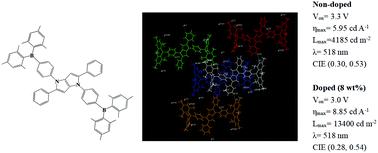当前位置:
X-MOL 学术
›
J. Mater. Chem. C
›
论文详情
Our official English website, www.x-mol.net, welcomes your feedback! (Note: you will need to create a separate account there.)
Synthesis, crystal structure, aggregation-induced emission (AIE) and electroluminescence properties of a novel emitting material based on pyrrolo[3,2-b]pyrrole
Journal of Materials Chemistry C ( IF 5.7 ) Pub Date : 2020-09-11 , DOI: 10.1039/d0tc03431b Hongbo Wang 1, 2, 3, 4 , Jinnan Huo 1, 2, 3, 4 , Hongbo Tong 1, 2, 3, 4 , Xuehong Wei 1, 2, 3, 4 , Ying Zhang 1, 2, 3, 4 , Yanbo Li 1, 2, 3, 4 , Shuming Chen 4, 5, 6, 7 , Heping Shi 1, 2, 3, 4, 8 , Ben Zhong Tang 9, 10, 11, 12, 13
Journal of Materials Chemistry C ( IF 5.7 ) Pub Date : 2020-09-11 , DOI: 10.1039/d0tc03431b Hongbo Wang 1, 2, 3, 4 , Jinnan Huo 1, 2, 3, 4 , Hongbo Tong 1, 2, 3, 4 , Xuehong Wei 1, 2, 3, 4 , Ying Zhang 1, 2, 3, 4 , Yanbo Li 1, 2, 3, 4 , Shuming Chen 4, 5, 6, 7 , Heping Shi 1, 2, 3, 4, 8 , Ben Zhong Tang 9, 10, 11, 12, 13
Affiliation

|
A novel electroluminescent (EL) material based on a pyrrolo[3,2-b]pyrrole skeleton as a donor group and dimesitylborane as an acceptor group, 1,4-bis(4-(dimethylboryl) phenyl)-2,5-diphenyl-1,4-dihydropyrrolo[3,2-b]pyrrole (DMBPDPP), has been successfully synthesized and fully characterized by elemental analysis, mass spectrometry, NMR spectroscopy and X-ray crystallography. Furthermore, the thermal stability and the electrochemical as well as photophysical properties including aggregation-induced emission (AIE) behaviors were systematically investigated not only by experimental methods but also by theoretical calculations. Herein, we found that the compound exhibits high thermal stability, electrochemical stability and significant AIE behaviors. X-ray crystal analysis assisted with DFT calculation provides insights into the origin of the luminescence properties and AIE characteristics. In addition, a non-doped OLED (device A) and doped OLEDs (device B, device C and device D) were fabricated with DMBPDPP and DMBPDPP in the CBP host as light-emitting layers, respectively. Among these OLEDs, the non-doped OLED (device A) shows excellent EL efficiencies of 4158 cd m−2, 5.95 cd A−1, 5.30 lm W−1 and 2.04%. The doped OLED (device C) with 5 wt% DMBPDPP in CBP shows better maximum brightness, maximum current efficiency, maximum power efficiency and external quantum efficiency of 13 500 cd m−2, 8.64 cd A−1, 8.44 lm W−1 and 2.83%, respectively. The electroluminescent properties of the compound demonstrate that DMBPDPP is a potential candidate for fabricating electroluminescent devices.
中文翻译:

基于吡咯并[3,2-b]吡咯的新型发光材料的合成,晶体结构,聚集诱导发射(AIE)和电致发光性能
一种基于吡咯并[3,2- b ]吡咯骨架作为供体基团和二聚三氯乙烷作为受体基团,1,4-双(4-(二甲基硼基)苯基)-2,5-二苯基的新型电致发光材料-1,4-二氢吡咯并[3,2- b ]吡咯(DMBPDPP)已成功合成,并通过元素分析,质谱,NMR光谱和X射线晶体学进行了全面表征。此外,不仅通过实验方法而且通过理论计算系统地研究了热稳定性,电化学以及包括聚集诱导发射(AIE)行为在内的光物理性质。在此,我们发现该化合物表现出高的热稳定性,电化学稳定性和显着的AIE行为。借助DFT计算的X射线晶体分析可洞察发光特性和AIE特性的起源。此外,使用DMBPDPP和DMBPDPP制造了非掺杂的OLED(设备A)和掺杂的OLED(设备B,设备C和设备D)。在CBP主体中分别作为发光层。在这些有机发光二极管中,非掺杂的OLED(设备A)示出了优异的EL效率的4158 CD米-2,5.95光盘-1,5.30流明w ^ -1和2.04%。OLED(器件C),用5%(重量)的掺杂DMBPDPP在CBP显示更好最大亮度,最大电流效率,最大功率效率和13为500cd米外部量子效率-2,8.64光盘-1,8.44流明w ^ -1和分别为2.83%。该化合物的电致发光性能证明DMBPDPP是制造电致发光器件的潜在候选者。
更新日期:2020-10-06
中文翻译:

基于吡咯并[3,2-b]吡咯的新型发光材料的合成,晶体结构,聚集诱导发射(AIE)和电致发光性能
一种基于吡咯并[3,2- b ]吡咯骨架作为供体基团和二聚三氯乙烷作为受体基团,1,4-双(4-(二甲基硼基)苯基)-2,5-二苯基的新型电致发光材料-1,4-二氢吡咯并[3,2- b ]吡咯(DMBPDPP)已成功合成,并通过元素分析,质谱,NMR光谱和X射线晶体学进行了全面表征。此外,不仅通过实验方法而且通过理论计算系统地研究了热稳定性,电化学以及包括聚集诱导发射(AIE)行为在内的光物理性质。在此,我们发现该化合物表现出高的热稳定性,电化学稳定性和显着的AIE行为。借助DFT计算的X射线晶体分析可洞察发光特性和AIE特性的起源。此外,使用DMBPDPP和DMBPDPP制造了非掺杂的OLED(设备A)和掺杂的OLED(设备B,设备C和设备D)。在CBP主体中分别作为发光层。在这些有机发光二极管中,非掺杂的OLED(设备A)示出了优异的EL效率的4158 CD米-2,5.95光盘-1,5.30流明w ^ -1和2.04%。OLED(器件C),用5%(重量)的掺杂DMBPDPP在CBP显示更好最大亮度,最大电流效率,最大功率效率和13为500cd米外部量子效率-2,8.64光盘-1,8.44流明w ^ -1和分别为2.83%。该化合物的电致发光性能证明DMBPDPP是制造电致发光器件的潜在候选者。












































 京公网安备 11010802027423号
京公网安备 11010802027423号